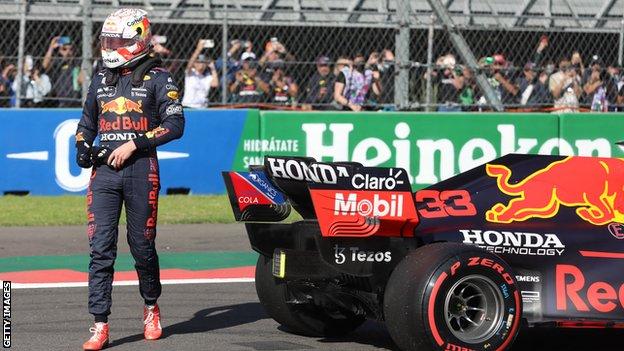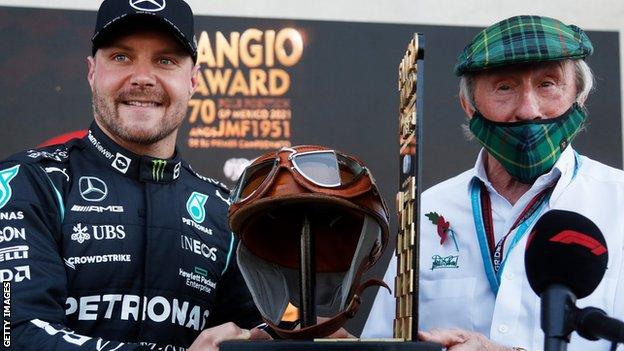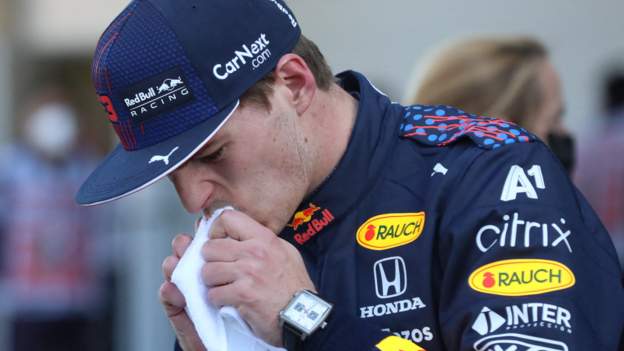
Valtteri Bottas said he “definitely surprised myself”, while Lewis Hamilton was “shocked”, and said he could not explain it. But however it came about, Mercedes gave Hamilton’s title hopes a fillip by locking out the front row at the Mexico City Grand Prix.
The man who had been favourite for pole position, Max Verstappen, had his own explanations of sorts for how he had ended up third on the grid instead after he and his Red Bull team had dominated the weekend up until Saturday afternoon’s qualifying session.
But almost as soon as the results came in, all three men’s attention had already turned to the start of the race on Sunday.
The run to the first corner in Mexico City is the second longest on the calendar, and Bottas and Hamilton were quickly pondering how to prevent the effect of the slipstream launching Verstappen ahead of them by the time they reach Turn One on Sunday.
“Track position is pretty important here,” Hamilton said, “so we will work as a team to try keep it.”
After what promises to be a tense first few seconds fraught with potential risk for all contenders, there are 71 laps for the two teams and their four drivers to dispute a race that could well be pivotal in the destiny of this year’s championship.
Verstappen, whose team-mate Sergio Perez joins him on the second row, starts it 12 points ahead. A victory on Sunday would nudge his championship lead close to a clear race victory with just four races left. From Hamilton’s point of view, he could really do with beating Verstappen on Sunday.

Mercedes find unexpected pace
A gripping qualifying session produced a grid almost no-one would have predicted and it sets up an intriguing race. With the four Mercedes and Red Bull cars starting together, this fight will be about strategy as much as speed.
First, though, the small matter of how Mercedes managed to turn the tables on a Red Bull team that had dominated the practice sessions in Mexico, as Mercedes had expected them to do.
There are a number of factors at play here. Firstly, in the past Mercedes have had an engine deficit in Mexico, their power-unit less able to compensate for the thin air at 2,200m altitude than the Honda in the Red Bull.
Some fine-tuning of the Mercedes engine has eliminated that, but there still remained the losses inherent in the Mercedes car, which at the maximum downforce setting required in Mexico simply produces less aerodynamic load than the Red Bull.
“From first practice onwards,” Hamilton said, “we have generally been behind by half a second. We have been working away at trying to improve the car but knowing they have generally got higher downforce than us, they have bigger wing they use in places like Monaco.
“So we have struggled in certain parts of the track so it’s a real surprise and shock to see us on the front row. I don’t really have an answer for it. But I will take it for sure.”
Part of the explanation lies in an outstanding performance from Bottas, who is counting down the days of his Mercedes career as the team prepare for the arrival of George Russell alongside Hamilton in 2022, and appears to be driving with freedom.
Hamilton was not happy with the balance of his car, but that should take nothing away from Bottas’ lap. Hamilton praised what he called an “amazing job”; Bottas thought it was possibly the best qualifying performance of his career. It beat Hamilton by 0.145secs.
Verstappen, meanwhile, thought he knew what had gone wrong – and the answer lay in the tyres, which have a notoriously narrow working temperature window, and when they are not in it, grip falls off a cliff.
Verstappen lost pace from the start of second qualifying, when the teams ran on the medium tyres to lock the more durable compound in for use at the start of the race, and it was even worse on the softs in the final session.
“We were struggling somehow with getting the tyres to work,” Verstappen said. “On the mediums it wasn’t too bad. But on the softs going into Q3 it just didn’t click on the first run.
“It was a terrible lap, just no grip. I knew there was something more in it if we could find a better balance with the tyres. It was a little better in the final run and we were on for a good lap and to challenge Valtteri’s time.”
Verstappen had been 0.35secs off Bottas on the first run. By the mid-point of his final lap, he was still slower than Bottas’ time, but was up by 0.2secs on his own previous lap – and with the stadium section, where he had been so strong all weekend, still to come.
But then the Red Bulls came across Yuki Tsunoda’s Alpha Tauri meandering around slowly at the Esses.
It was very much not a position in which a driver for the Red Bull junior team should have found himself – with the two Red Bulls, Perez in front of Verstappen, bearing down on him on the final lap of qualifying trying to beat the Mercedes.
Tsunoda went off the track. Perez, lacking downforce behind him, followed him off. Verstappen, behind Perez, just saw a big cloud of dust, expected yellow caution flags and had to back off. And that was his chances of the front row or perhaps even pole gone.
To risk it, or not to risk it
Red Bull tyre problems or not, it was an impressive turnaround by Mercedes.
“We were all surprised,” team boss Toto Wolff said. “It was pretty obvious [beforehand] that Max would take pole and it would be a fight between us and Checo [Perez] for the other positions.
“We could see that qualifying really came towards us. On the medium we started to outperform them and at no point did they have the lead in Q3.
“So it makes the sport for me so fascinating that from one session to the other performance can swing. We saw it to our detriment [at the last race] in Austin and now it has happened to our advantage here in Mexico.”
The long runs on Friday had already suggested Mercedes would be a much more competitive proposition in the race even if they were lagging on one lap. Now, they start a race in which they can realistically expect to be evenly matched on pace with Red Bull with both cars at the front.
But many potential pitfalls await for all.
The first corner combination at Mexico – a right-left-right combination after a very long straight – often produces a hectic start. And the chances of action and car damage there are high – as Hamilton and Verstappen, who have tangled there before, know only too well.
The run to the first corner is only slightly shorter than that at Russia’s Sochi circuit, where drivers often prefer to start third rather than first because of the power of the tow on the run to the first corner.
“It’s a little bit different [to Russia],’ Hamilton said. “It’s almost as long. But in Russia there is lot more drag and more tow effect. Here, there is less but there is still a tow effect, and so Valtteri and I will no doubt work as a team to try and hold one-two for the team.”
Bottas added: “To maintain the first two places you still need a really good start. If the guys behind have even a little bit better start, they will have an upper hand.”
Normally, Verstappen can be expected to be aggressive in his quest to gain positions. And so far, the pressures of the title fight and the risks of losing points have not changed that approach.
Might he be more circumspect now with a points advantage to protect so close to the end of the season, especially knowing that there is a long race ahead and that with Red Bull’s fleet-footed strategists at his back, there is a more than decent chance he could wrest the lead back if he cannot grab it at the start? Red Bull have already pulled this off twice this season – in France back in the summer, and in Austin two weeks ago.
Hamilton’s reference to track position being key harks back to his victory in Mexico in 2019 – another unexpected situation.
Then, Ferrari handed the advantage to Hamilton by strategic errors which gave him a position at the front that he never lost.
Knowing that, Mercedes are determined not to do the same themselves. And Verstappen will be equally keen to claim it for himself.
“It feels really good as it was somehow unexpected,” team principal Toto Wolff said. “But it is all about catching up these valuable points. That’s clear. Most important is to stay ahead at the start and from there it is easier to manage the race.”
